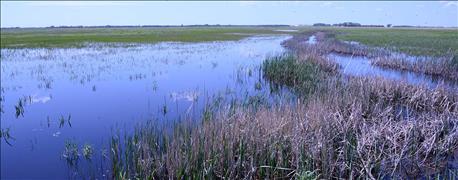
The Minnesota Natural Resources Conservation Service recently celebrated a conservation milestone.
Last year, the Minnesota NRCS completed its 1,000th conservation easement in the state. It celebrated the accomplishment recently at an easement site in the Red River Valley near Ulen.
Minnesota is one of only five states in the nation to have completed 1,000 easements since the program began in 1993. The easements cover more than 126,000 acres and protect agricultural land, grasslands, wetlands, forests and tree stands, says Cathee Pullman, Minnesota NRCS state conservationist.

Water flows through into a restored wetland on a conservation easement near Ulen.
Nationally, there are about 14,500 voluntary conservation easements in place on nearly 2.7 million acres. NRCS and its partners have spent $4.3 billion on the easements and on restorations.
Kirk Hanlin, USDA NRCS assistant chief attended the ceremony which was held on the edge of the restored wetland and upland prairie.
“This is what good government looks like,” he said.
NRCS pays the landowners for the easement deed restrictions, which govern how the land can be used.
NRCS and its partners pay to restore grasslands, wetlands and wildlife habitat on the property.
The landowners continue to own the land and continue to pay taxes on the land.
The easements provide many benefits, Hanlin said. They conserve agricultural land, prevent flooding, improve water quality and soil health and create wildlife habitat.

Conservation officials will use the control structure built into a low-head embankment to help manage the amount of water held on the easement site.
The Ulen site as a good example of conservation easements. It covers more than 1,000 acres and involves more than seven landowners. The property lies between two Lake Agassiz beach ridges, is poorly drained and floods frequently in the spring. The soil is light and sandy and tends to dry out during the growing season. The tendency to flood and then dry out made it marginal cropland.
When the landowners signed the easements, NRCS and its partners restored wetlands and upland prairie on the site. They removed a township road that ran through the property, built a low head embankment to help hold back 1-3 feet of water during high run-off periods, and created or restored several shallow wetlands for waterfowl resting, nesting and feeding.
In a few years, the land will look much like it did before it was farmed.
There is growing interest in such conservation easements, Pullman says. Minnesota NRCS has closed another 50 since reaching the 1,000-easement milestone.
About the Author(s)
You May Also Like






